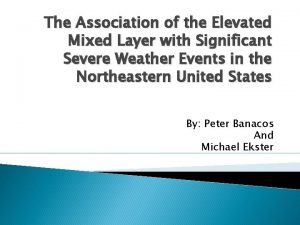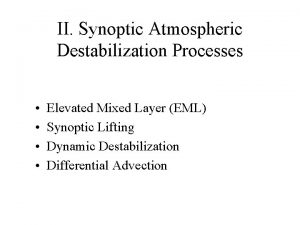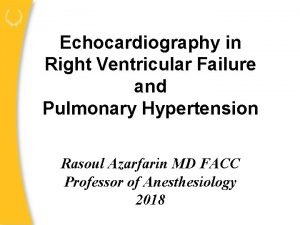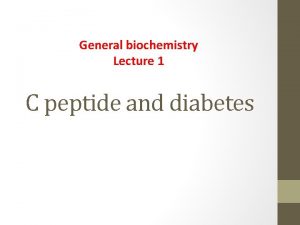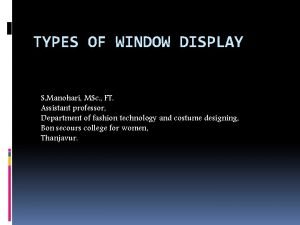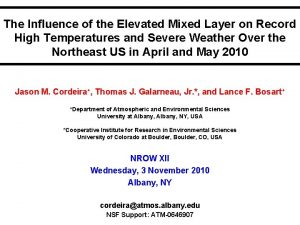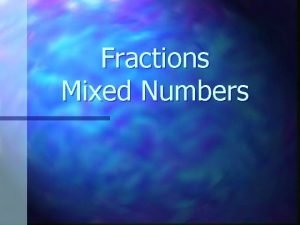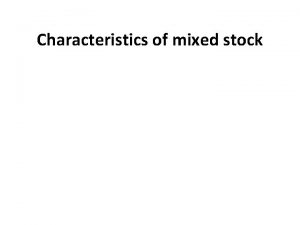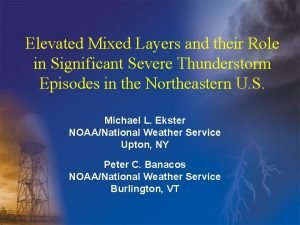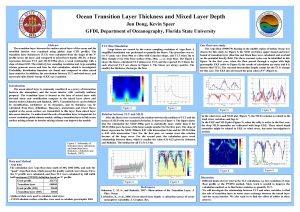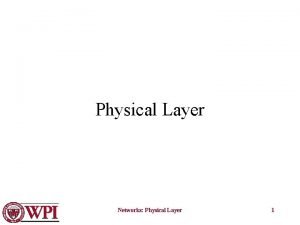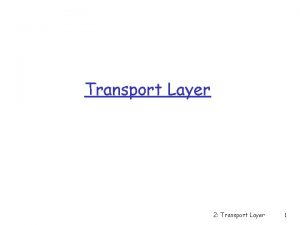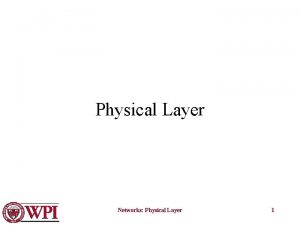The Association of the Elevated Mixed Layer with





















- Slides: 21

The Association of the Elevated Mixed Layer with Significant Severe Weather Events in the Northeastern United States By: Peter Banacos And Michael Ekster

What is Elevated Mixed Layer? (EML) � The horizontally advected hot, dry, and deeply mixed boundary layer air over areas of lower terrain. � Lies atop an interface of strong static stability, creating CIN � Similar to a “loaded gun” sounding. � Late spring / summer phenomenon

What is the EML?

Why EML? � EML formation is well understood, however its movement, evolution, and inevitable dissipation has received less attention � Johns and Dorr (1996) � Farrell and Carlson (1989) ◦ Solely focused on tornadoes and not derechos or large hail events ◦ Performed prior to high-powered compositing techniques � This paper attempts to catalog significant severe weather ◦ Hail >2 in. (5. 1 cm) in diameter, ◦ Convective wind gusts >65 kt (33 m s^-1) ◦ Tornadoes of >F 2 intensity

Lapse Rate Tendency Equation �

� As well as differential ageostrophic temperature advection being positive (downstream of amplifying baroclinic wave, jet entrance, or frontogenetic circulation)

Data and Methodology � 929 significant severe reports (3% of original 30, 617 reports) � EML soundings were chosen based on: ◦ An elevated lapse rate ≥ 8°C/km through a depth of 200 h. Pa or greater ◦ An increase in environmental relative humidity with height from a minimum at the bottom of the layer of steep lapse rate, through the depth of the steep lapse rate layer � 34 significant severe weather days from 19702006 that met an “EML” criterion. � This accounted for only 0. 1% of severe weather reports in the NE, but owed to 52. 9% of fatalities and 45% of injury totals.

Data and Methodology � Constructed composite analyses of 700 h. Pa heights and temperatures, 700 -500 h. Pa lapse rates, LI, and MSLP. � Backward Lagrangian trajectories at 250 h. Pa AGL, and every km up to 6 km for a duration of 96 hours.

Composite Analysis • 700 h. Pa height anomalies • EML events have a stronger northerly displaced ridge and heights anomalies of 36 m. • Placement of ridge and trough allow for a westerly geostrophic flow.

Composite Analysis • 700 h. Pa temperature anomalies • Positive anomaly maxima moves from central plains to the Northeast. • Anomalies of +3°+3. 5°C exist.

Composite Analysis • 750 -500 h. Pa lapse rate • The EML composite mean value is 7. 5°-8°C km • Anomalies are +1°C/km • Plume extends across Great Lakes region. • Important because EML plume shows steeper lapse rates.

Composite Analysis • LI and MSLP • MSLPs are similar in EML and non-EML cases • Illustrates importance of atmosphere aloft-EML Plume. • Greater potential instability in the EML composite.

Trajectory Analysis • Anticyclonic curvature • Consistent with the 700 h. Pa ridge • Most originate over the Intermountain West • Similar paths to 700 h. Pa temperature anomalies and 750 -500 h. Pa lapse rate composites. • (b) represents 10 trajectories showing three-quarter or greater anticyclonic loops.

Trajectory Analysis • After t-51 h, parcel begins subsiding. • Dp/Dt shows subsidence 1 -2 prior to event followed by accent. • Subsidence strengthens capping inversion • Maintains EML plume by not allowing DMC. • Vertical velocity switches sign at t-14 h. • Rising motion allows cap to weaken and DMC fires.

Case Studies � Eastern New Yorkwestern Massachusetts tornadoes: 28 August 1973 � 350 km swath of severe weather � Associated with an EML event

Case Studies

Case Studies

Case Studies • Northern New England southern Quebec derecho: 5 July 1999

Case Studies

Case Studies

Conclusions: �
 Palapse
Palapse Elevated mixed layer
Elevated mixed layer Virginia ready mixed concrete association
Virginia ready mixed concrete association Secure socket layer and transport layer security
Secure socket layer and transport layer security Layer 6 presentation layer
Layer 6 presentation layer Layer 2 e layer 3
Layer 2 e layer 3 Fig 19
Fig 19 Secure socket layer and transport layer security
Secure socket layer and transport layer security Layer-by-layer assembly
Layer-by-layer assembly Pathway of food from mouth to anus
Pathway of food from mouth to anus Secure socket layer and transport layer security
Secure socket layer and transport layer security Layer 2 vs layer 3 bitstream
Layer 2 vs layer 3 bitstream Secure socket layer and transport layer security
Secure socket layer and transport layer security Mania definition
Mania definition Elevated t wave
Elevated t wave Define diction in literature
Define diction in literature Transpulmonary gradient interpretation
Transpulmonary gradient interpretation Elevated bilirubin
Elevated bilirubin Cerebrum
Cerebrum Elevated c peptide
Elevated c peptide Open window display
Open window display Elevated ridge of cerebral tissue
Elevated ridge of cerebral tissue
